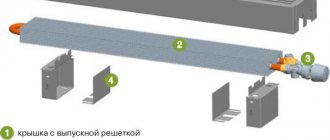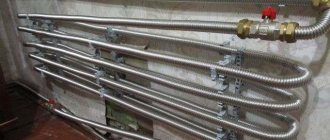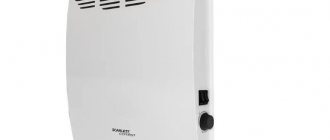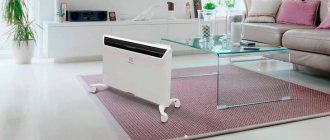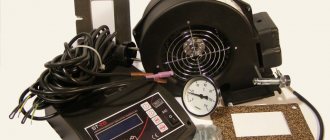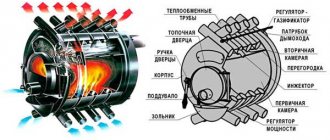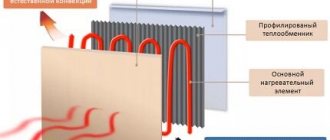For a comfortable atmosphere in a room, a central heating system is not always enough. In this case, as an alternative option, manufacturers offer convectors with electronic and mechanical control. Thanks to the design of the device, the user can optimize the process of heating the room. The built-in mechanical thermostat allows you to regulate the temperature with a deviation of 10C. Due to their affordable price, efficiency, and small amount of space, heating devices are popular among consumers.
Convector device with mechanical thermostat
The design of electric convectors has been modernized throughout the development of heating technology. Today, their production technology has been improved, and devices with mechanical control are cheaper than their electronic counterparts. This is due to the fact that the development of convectors requires less cost and occurs faster.
An electric convector with mechanical control consists of the following elements:
- frame;
- thermostat;
- heating element (heating element);
- air vents with guide louvers;
- fuse protecting against overheating;
- switch off/on buttons;
- multi-position switch for supplying voltage;
- built-in sensor against accidental tilt (additional option).
Important! The devices are intended for dry, ventilated rooms. If the room has high humidity, the housing material should be made of moisture-proof materials and be marked IP24.
Installation in a heating system
Installation in a heating system
Fixing the valve should be carried out on the part of the pipeline responsible for the water supply. The location of the head must correspond to the distance from direct heating sources in order to obtain adequate performance during operation.
Avoid situations where the regulator is located in a closed area that involves the placement in close proximity of pieces of furniture or textiles used to decorate the window space.
In situations where this cannot be avoided, it is recommended to use remote sensors that allow monitoring the operation of the system as a whole.
After the end of the heating season, it is recommended to completely dismantle the system in order to dry and clean it from possible mechanical deposits that cause contamination of the system and interfere with its proper operation.
Important: It is necessary to take into account that, unlike an electronic one, the mechanical version of the thermostat requires steps to set the values. This task is performed by influencing the throttle in order to obtain the required value.
Electronic thermostat and its features
Electronic temperature regulators are automatic type devices used when it is necessary to perform maintenance actions, temperature indicators of the liquid in the room heating system.
The mechanism operates through the direct action of parts of the system, which include a pump, mixer or boiler. The consumer who has set the required indicators receives the required temperature, regulated by the sensor throughout the season or by making adjustments to the readings.
Main varieties
Based on the principle of location, mechanically controlled convectors are divided into:
- wall;
- mounted;
- floor;
- universal.
The air is heated in devices in different ways, therefore, based on the heating method, heating equipment with a mechanical thermostat is divided into the following types: gas, water and electric convector.
Operating principle of an electric convector
It is known from the laws of physics that cold flows have a large mass, so there are air holes at the bottom of the device. Through them, the air passes from bottom to top through the heating element and exits through the grille back into the room. The design features of the product increased the area of interaction between oxygen and the heating element.
The basis of the device is a tubular heating element consisting of a high resistance conductor coated in a ceramic shell. It is placed inside an aluminum or steel housing. Thanks to the principle of natural circulation, the room becomes warm.
Looking for energy efficient solutions?
Pay attention to FORUMHOUSE geothermal heat pumps
Ground source heat pump EU (start/stop)
Geothermal heat pump IQ (pseudo-inverter)
IQ ground source heat pump (inverter)
One of the options for organizing the heating system of a country house is the use of autonomous heat sources not connected by a common main line. If previously these were mainly oil radiators, today electric convectors are becoming increasingly common. Among FORUMHOUSE participants, this heating method is also quite popular, not only in dachas where people visit on weekends, but also in permanent residences.
What are convectors
Unlike oil radiators and similar devices, convectors heat the air not only directly around them, but throughout the entire room due to convection - the cyclical movement of cold and warm air masses. Cold air from below enters the device through the lower grille, heats up passing through the heating element, exits through the upper grille and rises to the ceiling, cools down, falls again and enters the heater. Some models also have a fan that forcibly accelerates the circulation process.
Device
The convector is based on a heating element (heating element) of a tubular, needle or monolithic type, located in the lower part of an aluminum or steel body. Despite the fact that the heating element itself can heat up above 100⁰ C, the maximum temperature of the body is 60⁰ C – it’s hot, but does not threaten burns. This feature significantly expands the scope of application: even walls made of timber or logs are not an obstacle to installing the heater. The device is configured and controlled using a mechanical regulator or an electronic display; the mechanical version is less reliable, but cheaper; the electronics are more expensive, but more advanced.
Convectors are characterized by maximum efficiency (about 100%), which is explained by direct heating of air without intermediate energy consumption for heating the coolant.
All devices have efficiency, since you have decided on electric heating, then take into account the losses:
- Electric boiler -> coolant -> wiring -> radiators -> air heating.
- Oil radiator -> coolant -> radiator -> air heating.
- Convector -> air heating.
In addition, the heater can also be set to maintain a certain temperature, and it will operate in a given mode, turning on as needed, which significantly reduces energy consumption. During periodic visits to the dacha, the convectors are set to the “anti-freeze” mode (maintaining a minimum air temperature) and “stoked” upon arrival. If we are talking about branded models with programmers, then you can set the temperature increase on a certain day before arrival. There is also the possibility of remote control; it is discussed in detail in the corresponding topic on the forum.
The power of the devices varies over a wide range, which allows you to select a suitable unit based on the capabilities of the network and the square footage or volume of the room. As in the situation with any other heat sources, it is advisable to get 1 kW of heat per 10 m², provided that the house is well insulated.
Advantages and disadvantages of the device
This type of convectors has its advantages:
- low surface temperature;
- ability to withstand temperature changes;
- ease of operation and maintenance;
- low-temperature heating elements do not burn oxygen and do not emit foreign odors;
- high level of efficiency - more than 90%;
- low noise level;
- safety;
- easy installation of the device;
- inexpensive price compared to electronic control of the device;
- long service life.
Caring for the surface of the device
An electric convector is a heating device that, with the help of simple recommendations, will last for decades. To ensure the device functions for a long time, follow these tips:
- Periodically wipe dust accumulation areas with a damp cloth (air openings, top panel, thermostat);
- Wipe the device regularly with soapy water and then wipe dry;
- do not obscure the grilles with furniture, curtains or other things;
- in the summer, wrap the device in a plastic bag - this will protect the electric convector from insects and dust.
Note! The device works if circulation occurs unhindered in the air duct openings. To avoid device failure, do not cover the electric convector.
Reviews of popular models with a power of 2 kW
The modern market offers a huge number of convectors with a mechanical thermostat. The best models are presented with all the necessary functionality: double insulation of live parts, overheating protection, power selection and electricity saving. Let's look at some models.
ENSTO EPHBM20P
The electric convector with a mechanical thermostat 2000 W has dimensions of 152.3 x 38.9 x 8.5 cm. The temperature can be adjusted using a mechanical thermostat. The installation of the device is universal: both floor and wall. Weight approximately 8.6 kg. The device has additional options: frost protection, overheat shutdown. The disadvantages include uneven heat distribution over the housing area.
Convector ENSTO EPHBM20P
Noirot CNX-2 2000
The convector with a mechanical thermostat is of high quality. The French company Noirot is the largest manufacturer of heating equipment. The heating area of the device is 25 square meters with a power of 2 kW. The body is made of a protective coating. Dimensions 74 x 44 x 8 cm. Model CNX-2 2000 – compact, silent, with reliable wheels. The disadvantages of the model include low-quality legs, which break off during use, and a short cord. The product is premium class.
Convector Noirot CNX-2 2000
Electrolux ECH/AG2-2000 MF
The convector is made of a moisture-proof housing and has dimensions of 80 x 41.3 x 11.2 cm. The weight is small - 5.15 kg. Can be wall mounted and comes with additional wheels. Using a mechanical thermostat, you can set two power levels: 1000/2000 W.
Convector Electrolux ECH/AG2-2000 MF
Connecting the thermostat to the heater
Thermoregulator, thermostat, temperature controller and some similar names describe the same element from the heating control system. In particular, the thermostat is an integral element of almost any heater. The purpose of all thermostats is to somehow fix the required temperature and maintain it in some way.
All thermostats can be classified according to the following parameters:
1. According to the principle of temperature control:
- mechanical;
- electronic.
- removable;
- non-removable.
- on the heater itself;
- remote
- wired;
- radio controlled;
- self-programmable.
In the age of computer technology, mechanical thermostats are the easiest way to regulate temperature. Such thermostats have a slider or wheel with which the required temperature value is set and the heater maintains this temperature. A feature of heaters with a mechanical thermostat is the lack of precise temperature calibration on the thermostat body, and therefore it is impossible to set the exact temperature value, for example, 21C. This value can fluctuate within ± 1C, and in some cases more. Not all consumers like such precision of adjustment.
Often people want to see a specific numerical value for a set temperature. In this case, you should purchase a heater with a built-in or removable thermostat, which has a display, and where the required temperature value is set using buttons - this is an electronic thermostat. This value is displayed on the display. An electronically controlled thermostat is significantly more expensive than a mechanically controlled one. I would like to note the discrepancy in the definitions of “electronic thermostat” or “electronic temperature control”.
The principle of mechanical and electronic temperature control was described above. But the method of measuring and processing the temperature signal for all thermostats existing today is almost the same - electronic.
The location and connection of thermostats to heaters can also be different. The most budget version of the heater has a built-in thermostat, which can be removed and replaced with another one. Nobo heaters have a line with such a built-in thermostat - the Nordic series. More common Nobo heaters are models with removable thermostats. It is easily removed and replaced. Today, all heaters of the NFC, NFK, NTE, NTL series have a removable thermostat. Heaters with a built-in thermostat are cheaper and less mobile in the control system.
The thermostat installation can also be varied. Most often it is attached to the convector itself, regardless of whether it is removable or not. The heater control circuit is the same in all cases. Much less common is a slightly different scheme for the operation of the heater and thermostat. The thermostat itself is located in a convenient or easily accessible place, and the heater is located in another place. In this case, the thermostat controls the operation of the convector either via a wired connection or via a radio signal. In both cases, the temperature that must be maintained in the room is set on the thermostat.
Nobo pays special attention to how to control heaters and, accordingly, thermostats. Depending on the requirements of the consumer himself, he can choose one of three existing control methods. The simplest control of a Nobo convector (and not only Nobo) is manual control using a thermostat. Its connection to heaters can be achieved through thermostats: removable or non-removable, mechanical or electronic. In any version, the consumer sets the required temperature with his own hand, and the heater maintains it. That is why the control is called “manual”. With this control there can be only one set temperature value, but at any time it can be changed manually.
A more modern and convenient way today is to install radio-controlled thermostats on heaters. Today, Nobo is the only company that widely implements remote control technology for heaters using wireless communication. Connection to convectors can be made through removable or non-removable thermostats. It is difficult to find such systems on the market, but they use non-removable thermostats. Nobo has five types of removable thermostats, three of which are radio controlled. Among them are mechanical and electronic.
Radio-controlled thermostats are marked with the letter “R” - NCU 1R, NCU 2R, NCU ER. For remote control, you should purchase additional equipment - an Eco Hub control unit, which connects to the router. The initial control tool is a smartphone or tablet on which the Nobo Energy Control program is installed free of charge. After all the necessary settings from the smartphone, the consumer transmits the necessary signals via the wi-fi router, which communicates via cable with the Eco Hub, and the latter transmits all the necessary operating modes to the heater thermostat via a radio channel. If the router is connected to the Internet, then control can be carried out from anywhere in the world where there is Internet.
Radio-controlled thermostats usually have more functionality than manual thermostats. In addition to remote control, in the Nobo Energy Control program you can prescribe the time to turn the convector on and off during the day, for a week, and then repeat it weekly. It is possible to set the numerical value of several temperatures (modes). Nobo heaters have 4 modes: comfortable, which corresponds to the maximum temperature in the room when people are there; economical mode, which corresponds to a lower temperature in the room when there are no people there for a while; anti-freeze (anti-freeze) mode, which corresponds to a temperature from + 5C to + 8C in the room when there is no one there for a long time; “all off” mode, which corresponds to the shutdown of electricity to the heaters, and the thermostats go into sleep mode. An unlimited number of heaters can be connected to one Eco Hub control unit. The radio signal range from the Eco Hub to the heater is 100 meters of line of sight, but each of the radio-controlled thermostats is a repeater of signals from the Eco Hub. Such a remote control system is in great demand among consumers who have a country house, and in winter, when there are no people for a long time, there is no need to completely warm up the house, and if necessary, at any time you can contact using a smartphone and make all the necessary changes.
Nobo has another control method. It can be called intermediate between manual control and remote control; these are self-programmable thermostats.
Marking of such a thermostat is Nobo NCU2T. It is removable, with electronic control and temperature setting on the display. There is no need to purchase additional equipment for it to work. All the appropriate settings are made on the thermostat itself, its operation is programmed for 24 hours, 7 days a week, followed by weekly repetition. It is possible to program any two temperatures during the day. All adjustments and changes in settings are made manually. In terms of price, such a thermostat is cheaper than a radio-controlled one with an entire control system, but it is more difficult to configure. If there is a frequent and prolonged power outage (more than a day), then the self-programming thermostat resets all settings and when electricity appears, it begins to work in a chaotic mode.
Depending on the needs and financial capabilities, the consumer can choose any type of Nobo thermostat, and if desired, easily and quickly change the thermostat and switch to another control method, from manual to radio-controlled or vice versa.
